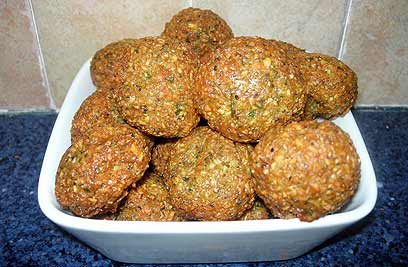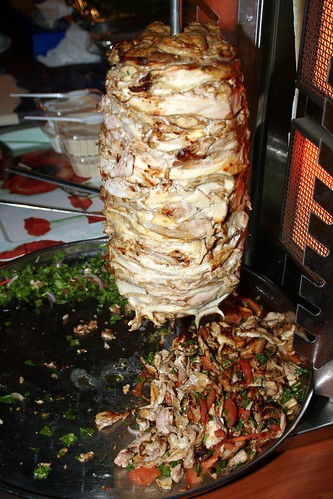
Its amazing how the Arab - Israel conflicts extends to areas outside of the political and military arenas. This article, from gulfnews.com even includes a 1930's style Jewish characature, this time with 'the Jew' as 'cuisine grabber'.
To me its pretty obvious that Jews having lived all over Europe and the Middle-East have adapted various dishes. I am sure, for example that we didn't invent the bagel, but maybe we did take it and spread its popularity.
Why, I ask, can't people of the Mediterranean and Middle-East celebrate the fact that their food has been absorbed into Israeli culture?
Here's the article:
The undeclared war on Arab cuisine
| http://archive.gulfnews.com/opinion/columns/region/10150036.html |
My niece, Irene, called me a few days ago indignant that some of her American friends, including some Jews, keep describing typical Arab foods such as falafel, hummus and shawarma, among others, as Israeli.
She wanted to know how she can convince them this is not the case.
I am quite familiar with this problem since many Americans have been aware of this undeclared war at many unsuspecting restaurants specialising in Mediterranean cuisine, or coverage in the media. My first confrontation with this issue came in 1969 when the late Leah Rabin, wife of the assassinated Israeli prime minister Yitzhak Rabin who was then his country's ambassador in Washington, discussed in a New York Times interview Israeli cuisine, and praising labneh (strained yogurt) as healthful food.
My first impulse was to tell my niece that Israel was almost 60 year old and these food items have obviously existed long before then. My curiosity prompted me to "google" Israeli foods. The internet yielded tens of references, including the Israeli Ministry of Foreign Affairs website which carried a feature on Israeli foods.
I couldn't believe my eyes and wished the Arab governments would do the same, but knowing their ineptitude at explaining more life-and-death issues I doubted they will tackle this quiet Israeli attempt at usurping Arab foods. So I did not bother to check but I would like to be proven wrong.
As a matter of fact, Arab-Americans are used to reading sometimes the wildest of statements made against Arabs or Muslims. Two such items appeared in the press this week.
In an Op-Ed column published in The Washington Post, Nina Shea complains about the alleged "cleansing campaign" now underway against non-Muslim minorities in Iraq. Shea, director of the Hudson Institute's Centre for Religious Freedom and a commissioner on the US Commission on International Religious Freedom, saw this action as similar to what happened "sixty years ago (to) Iraq's flourishing Jewish population, a third of Baghdad, (that) fled in the wake of coordinated bombing and violence against them". Of the 125,000 only 6,000 remained in Iraq and the remainder settled in Israel.
You would think that Shea would have checked her facts before making these outrageous and disputed allegations.
Naeim Giladi, an Iraqi Jew who fled to Israel and later settled in the US, maintains in an article that appeared in The Link (April - May 1998) and his book, Ben Gurion's Scandals: How the Haganah & the Mossad Eliminated Jews that "the terrible truth is that the grenades that killed and maimed Iraqi Jews and damaged their property were thrown by Zionist Jews". He also pointed out that Wilbur Crane Eveland, a former senior officer in the Central Intelligence Agency (CIA), wrote in his book, Ropes of Sand, published in 1980, that "in attempts to portray the Iraqis as anti-American and to terrorise the Jews, the Zionists planted bombs in the US Information Service library and in synagogues (and) soon leaflets began to appear urging Jews to flee to Israel."
The second incident this week involved New York's newest public school in memory of a world-famous Lebanese-American philosopher and poet, Gibran Khalil Gibran, a Christian, and the city's first to offer instruction in Arabic and on Arab culture. Consequently, it has been has been targeted by critics who alleged that the school will serve as "a potential radical-Islam training ground".
The school's original principal, Debbie Al Montaser, an Arab-American, had to quit for her failure to condemn the use of the word "intifada", a term used by Palestinian Arabs to describe their uprising against Israeli occupation. Danielle Salzberg, a Jewish woman who does not speak Arabic, has been named her interim successor.
Distortions
To cite but one of many distortions and claims about the authenticity of Israeli cuisine, Joan Nathan, author of The Foods of Israel and whose writings and recipes appear on MyJewishLearning.com, maintains that falafel is "the ultimate Israeli food".
On the other hand, Daniel Rogov, the restaurant and wine critics of Haaretz, the leading Israeli newspaper, acknowledges that "despite these longstanding myths, there is nothing Israeli about falafel, shawarma, borekas or hummus ...." and added that "in order to set the culinary record straight, let it be known that falafel .... outdates the existence of the State of Israel by several thousand years, archeologists having discovered the remains of ground chickpeas in the tombs of several of the Pharaohs. Shawarma ... (is) Turkish in origin, as are borekas ... As for hummus, most food historians agree the dish originated some 4,000 years ago, probably in North Africa." Interestingly, his lengthy review titled The International Israeli Table which appears on the Israeli Ministry of Foreign Affairs, was written three years ago.
Now that the record is hopefully set straight, I am just leaving to have a falafel sandwich at the best falafel and shawarma sandwich in the Washington, D.C. area, prepared by two Palestinian Arab cooks from Israel and working at a neighbourhood Jewish (kosher) restaurant.
George S. Hishmeh is a Washington







